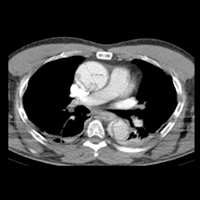A "sneaky" symptom of aortic dissection. Brief literature review, physiopathology and diagnostic tools management

Submitted: October 29, 2020
Accepted: December 23, 2020
Published: March 9, 2021
Accepted: December 23, 2020
Abstract Views: 1336
PDF: 828
Publisher's note
All claims expressed in this article are solely those of the authors and do not necessarily represent those of their affiliated organizations, or those of the publisher, the editors and the reviewers. Any product that may be evaluated in this article or claim that may be made by its manufacturer is not guaranteed or endorsed by the publisher.
All claims expressed in this article are solely those of the authors and do not necessarily represent those of their affiliated organizations, or those of the publisher, the editors and the reviewers. Any product that may be evaluated in this article or claim that may be made by its manufacturer is not guaranteed or endorsed by the publisher.
Similar Articles
- Antonio D’Aloia, Enrico Vizzardi, Pompilio Faggiano, Claudia Fiorina, Livio Dei Cas, Intracranial bleeding mimicking an extensive acute myocardial infarction with reversible apical ballooning and systolic left ventricular dysfunction. A case report , Monaldi Archives for Chest Disease: Vol. 68 No. 1 (2007): Cardiac series
- A. Yilmaz, G. Bektemur, G.H. Ekinci, E.A. Ongel, M. Kavas, O. Haciomeroglu, M. Demir, B. Burunsuzoglu, Extralobar pulmonary sequestration: a case report , Monaldi Archives for Chest Disease: Vol. 79 No. 2 (2013): Pulmonary series
- A. Srinivasan, R. Agarwal, Cardiovocal syndrome , Monaldi Archives for Chest Disease: Vol. 75 No. 4 (2011): Pulmonary series
- F. Iaselli, G. Rea, S. Cappabianca, G. Fabozzi, M. Montemarano, C. Vitale, A.A. Stanziola, R. Muto, A. Rotondo, Adult-onset pulmonary involvement in Niemann-Pick disease type B , Monaldi Archives for Chest Disease: Vol. 75 No. 4 (2011): Pulmonary series
- Cinzia Perrino, Laura Scudiero, Maria Piera Petretta, Gabriele Giacomo Schiattarella, Mario De Laurentis, Federica Ilardi, Fabio Magliulo, Giuseppe Carotenuto, Giovanni Esposito, Total occlusion of the abdominal aorta in a patient with renal failure and refractory hypertension: a case report , Monaldi Archives for Chest Disease: Vol. 76 No. 1 (2011): Cardiac series
- Giovanni Esposito, Luigi Di Serafino, Giuseppe Gargiulo, Anna Sannino, Gabriele Giacomo Schiattarella, Anna Franzone, Cinzia Perrino, Massimo Chiariello, Rotational atherectomy for the treatment of isolated femoral artery traumatic lesion: a case report , Monaldi Archives for Chest Disease: Vol. 72 No. 3 (2009): Cardiac series
- Filippo M. Sarullo, Luigi Americo, Salvatore Accardo, Sergio Cicero, Rossella Schicchi, Maria Schirò, Antonio Castello, Tako-tsubo cardiomyopathy observed in a patient with sepsis and transient hyperthyroidism , Monaldi Archives for Chest Disease: Vol. 72 No. 1 (2009): Cardiac series
- Leonardo Misuraca, Giovanni Benedetti, Anna Sonia Petronio, Marco De Carlo, Piersilvio Chella, Andrea Pieroni, Alberto Balbarini, Coronary artery anomalies and their clinical relevance , Monaldi Archives for Chest Disease: Vol. 76 No. 2 (2011): Cardiac series
- Donatella Ruggiero, Gianluigi Savarese, Roberto Formisano, Ada Bologna, Giacomo Mattiello, Elisabetta Pirozzi, Francesco Gambardella, Francesco Lo Iudice, Laura Petraglia, Alice Vitagliano, Laura Casaretti, Giuseppe Luca Della Ratta, Susanna Mosca, Pasquale Perrone Filardi, Endothelial dysfunction in type 2 diabetic patients with normal coronary arteries. A peripheral arterial tonometry study , Monaldi Archives for Chest Disease: Vol. 78 No. 1 (2012): Cardiac series
- Dario Amore, Emanuele Muto, Umberto Caterino, Dino Casazza, Alessandro Saglia, Pasquale Imitazione, Carlo Curcio, Anomalous segmental pulmonary vein: additional V6 behind the bronchus intermedius draining into the superior pulmonary vein , Monaldi Archives for Chest Disease: Vol. 92 No. 4 (2022)
<< < 3 4 5 6 7 8 9 10 11 12 > >>
You may also start an advanced similarity search for this article.

 https://doi.org/10.4081/monaldi.2021.1662
https://doi.org/10.4081/monaldi.2021.1662





